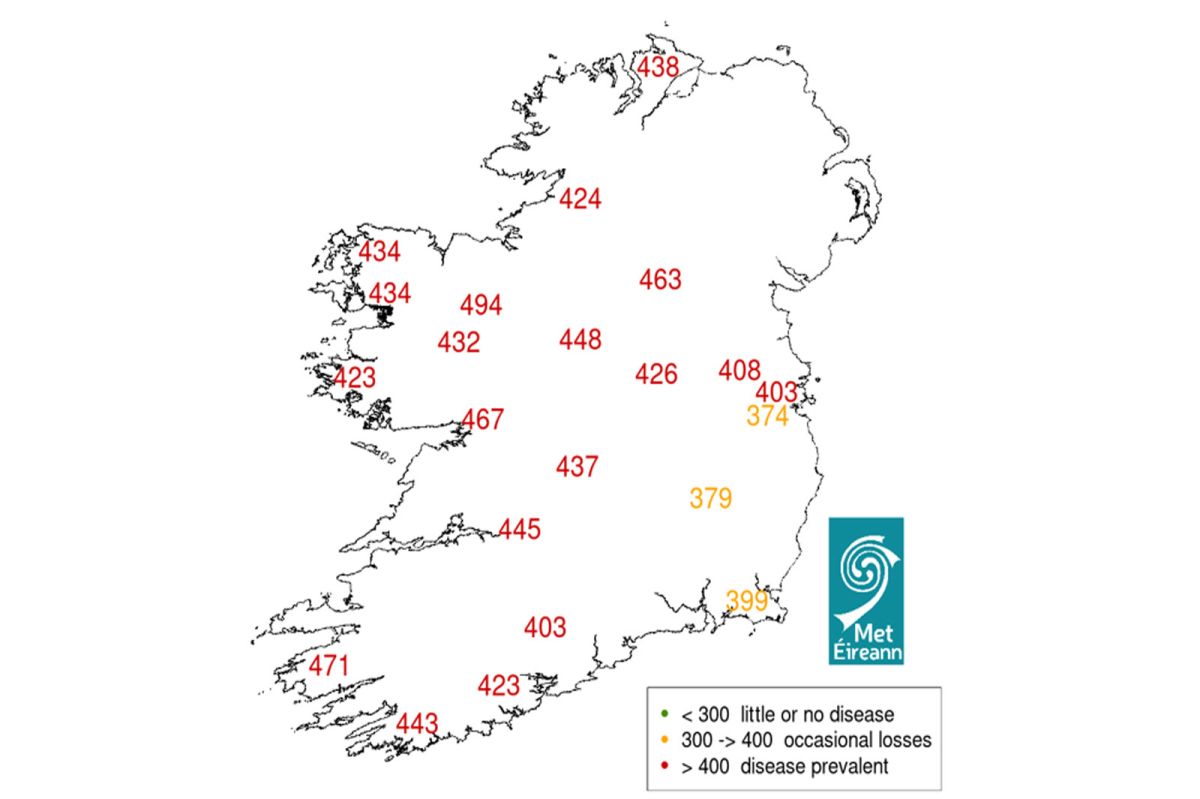Liver fluke forecast – infection prevalent across Ireland

Each year, the DAFM, in collaboration with Met Éireann, UCD, Teagasc and Animal Health Ireland advises farmers of the predicted risk of disease caused by liver fluke infection in livestock for that winter. This year’s forecast is based on meteorological data gathered between May and October 2023 by Met Éireann
The Ollerenshaw Summer Index 2023 predicts infection being prevalent, with high values of the index due to the warm, wet conditions experienced in July, August, September and October.
Animal Health Ireland
The Beef HealthCheck programme, run in partnership with Meat Industry Ireland, collects and reports liver fluke information in cattle at slaughter from participating meat factories nationwide. Overall, this year’s levels of liver fluke infection are slightly lower than those reported in the last few years. However, the consistently high rainfall this year could result in a higher risk of liver fluke on certain farms going into winter.
To date, abattoir examinations showed an average of 39 per cent of herds with at least one animal with liver damage due to liver fluke and live liver fluke parasites were seen in 12 per cent of herds. Counties in the northwest of Ireland were more heavily affected, with 70-80 per cent of herds in Sligo, Roscommon and Donegal reported to have signs of liver fluke at slaughter. The prevalence within herds is typically low depending on the farm with 6.6 per cent of animals presented to slaughter showing signs of liver fluke damage and 1.1 per cent of animals showing live liver fluke parasites. It is important for farmers to know whether liver fluke is present on their farm and to treat accordingly to avoid production losses
Regional veterinary laboratories
From June to December, the DAFM collects blood samples from lambs in meat factories from a proportion of flocks at the time of slaughter. These are tested for the presence of liver fluke antibodies to determine the timing and geographical spread of liver fluke exposure in grazing lambs. The number of flocks selected for sampling from each county is generally proportionate to the sheep population of that county over the entire sampling period. A number of samples are taken from each selected flock and these are pooled at laboratory level. The presence of liver fluke antibodies in 2023 born lambs is therefore a sentinel for exposure to liver fluke in the wider sheep population in the region, as by definition these lambs must have been exposed during the 2023 grazing season.
From July to October 2023, blood samples from 757 flocks across 26 counties were tested for the presence of liver fluke antibodies. Data from this survey indicates that the majority of infected flocks reside in counties in the west. Some positive and inconclusive results were reported in counties outside of the west and the northwest in the August testing, possibly associated with a high summer rainfall level. This was the case in the border areas, midlands, south and in Leinster where there was substantial evidence of fluke exposure in lambs by October.
Farm-to-farm variation
In order to assess the risk of liver fluke disease on any particular farm, various environmental factors, particularly climate, landform and soil type (especially whether soils are heavy or free draining) must be taken into account. This is because the intermediate host of the parasite, which is a mud snail (Galba truncatula), occurs in soil that is slightly acidic and muddy. Thus, areas with rushes or wet patches (e.g., around gates, troughs) are particularly important with regard to liver fluke risk as they can help to maintain a population of the infective stage of the parasite. In addition, livestock owners should factor in prior liver fluke history on the farm as this is an important indicator of future disease risks.
Treatment and control
In areas of high risk and on farms where liver fluke infection has been diagnosed or where there is a prior history, livestock owners should consult with their vet to devise an appropriate control programme. When using flukicides to control and treat liver fluke infection, particular attention should be given to dosing cattle at the time of housing or shortly thereafter, and sheep in autumn or earlier in the year, where indicated by faecal examination results or prior disease history. For sheep, a drug effective against early immature as well as late immature and mature flukes should be used to protect against acute disease. In addition, sheep should be moved from affected pasture to prevent re-infection. If the flukicide given to cattle at housing is not effective against early immature fluke, then faecal samples should be taken six to eight weeks after housing and tested for the presence of liver fluke eggs. This will determine whether a follow-up flukicide treatment is necessary. Where feasible, and as a long-term control option, areas of farms that provide suitable habitat for the mud snail such as wet muddy areas should be fenced off.




